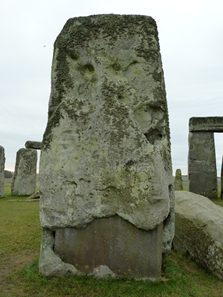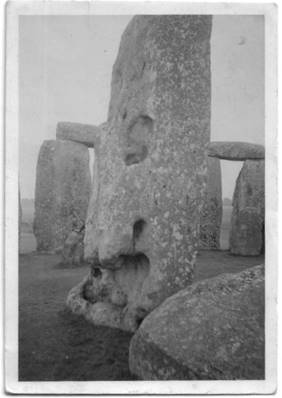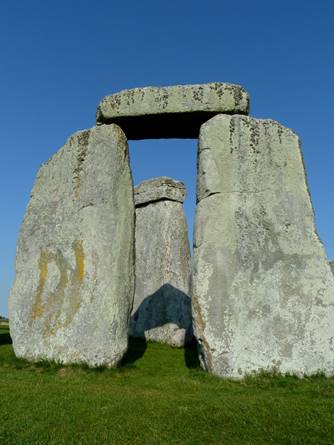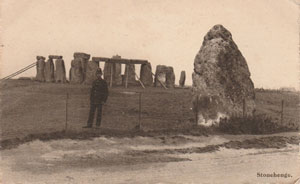Some of the frequently asked questions about Stonehenge. From the common to the bizarre!
“Why does that stone look like it's got another one inside it?”
 The stone being referred to here is Stone 60 – the remaining upright of the northwest trilithon. The side of the stone that faces visitors as the walk along the path nearest the monument has a very obvious smooth block that seems to go up inside it, with the actual stone looking like it's “dripped” over the top edge. The stone being referred to here is Stone 60 – the remaining upright of the northwest trilithon. The side of the stone that faces visitors as the walk along the path nearest the monument has a very obvious smooth block that seems to go up inside it, with the actual stone looking like it's “dripped” over the top edge.
 In fact this is a concrete repair that was carried out in 1959 to fill in a natual cavity at the base. Before the concrete was installed people used to shelter from the elements under the overhang here, and there were fears that the temptation to chip a bit away as a souvenir might lead to a catastrophic fracture or even collapse. As part of the work, the stone was also straightened up by a degree or two. In fact this is a concrete repair that was carried out in 1959 to fill in a natual cavity at the base. Before the concrete was installed people used to shelter from the elements under the overhang here, and there were fears that the temptation to chip a bit away as a souvenir might lead to a catastrophic fracture or even collapse. As part of the work, the stone was also straightened up by a degree or two.
Left is what it looked like before the repair.
“Why can't we go inside Stonehenge any more?”
You can on one of our inner circle out of hours tours, but during the day visitors are kept well away from the stones by a low rope barrier. By 1963 the popularity of Stonehenge as a destination meant that erosion caused by hundreds of thousands of visitors' feet had seriously damaged the grass within the circle, wearing it away down to the underlying chalk in places. It was a mud bath in the wet and a dustbowl in the summer.
The Ministry of Works took the decision to replace the grass with a layer of clinker from Melksham gasworks, topped off with gravel, in an attempt to prevent further damage. Left unchecked the erosion might have eventually resulted in some of the shallower-seated upright stones becoming loose in their sockets.
This turned out to be a terrible idea. Wind whipped the gravel around, shot blasting both the stones and visitors' legs, while gravel trapped in the treads of shoes further damaged the stones that people walked over or climbed on.
In 1978, overnight on the 15th March, signs went up informing visitors that from then on they would only be able to view the stones from a distance. The gravel and clinker was subsequently taken up, new topsoil laid and the grass restored to what was deemed to be the original ground level.
 The rationale for this wasn't just about the accidental damage. Unfettered access to the monument in the past had led to much carving of initials and names into the stones. From the late 1950s on, paint was often daubed on the monument with slogans such as “Ban the Bomb”, “Ferdie Slept Here” and “Radio Caroline” appearing overnight. The rationale for this wasn't just about the accidental damage. Unfettered access to the monument in the past had led to much carving of initials and names into the stones. From the late 1950s on, paint was often daubed on the monument with slogans such as “Ban the Bomb”, “Ferdie Slept Here” and “Radio Caroline” appearing overnight.
Fast growing, bright yellow, lichen on the eastern side of Stone 5 has colonised the bare patch where the painted D and I of “Radio” was scrubbed off by the custodians and the evidence of other letters can still be seen if you know where to look.
“When did the fence first go up?”
The fences first went up in May 1901 when it was under the ownership of the Antrobus family. A stone fell on the last day of 1900 and some of the other stones were leaning at an alarming angle. Antrobus argued that it was dangerous for visitors to go inside and the fence erected. At the same  time he started to charge 1 shilling (5p or the equivalent of £5.55p now) and employed a policeman to guard the stones. When the estate was sold in 1915 the records show that £720 net income was being generated from visitors! time he started to charge 1 shilling (5p or the equivalent of £5.55p now) and employed a policeman to guard the stones. When the estate was sold in 1915 the records show that £720 net income was being generated from visitors!
The new charges were not popular and a court case was taken out against Antrobus, but the judge agreed that he was entitled to do what he wished on his land.
“How did they get the lintels up on top?”
The honest answer is they we don't know, and we never will know, because the builders left us no written records. Experimental archaeology has tried a few ways to find out what works and in the absence of Merlin plus associated giants (the legendary explanation), there are two probable methods. The most obvious way is with a strong timber ramp and this was successfully demonstrated in the 1994 TV documentary “Secrets of Lost Empires”.
The alternate approach is by levering up each end of the lintel in turn, building a wooden platform underneath as you go and including the already standing adjacent uprights in this timber “cribbing” to provide stability.
The great advantage of the “lever – crib” method is you can stop for a rest at any point. You could even bring a lintel back down again if adjustments were necessary to the size or position of the mortise holes that fit over the pointed tenons on the uprights which hold the lintels in place.
“When was Stonehenge discovered?”
Obviously Stonehenge has been known about from the time it was constructed about 4,500 years ago but the first definite mention of it by name dates from about 1130AD in Henry of Huntingdon's book “Historia Anglorum” (The History of the English) where he writes:
“The second marvel is at Stonehenge (Stanenges), where stones of amazing bigness are raised in the manner of gateways”
There's no earlier reference by name, but an intriguing passage by Diodorus Siculus (a 1st Century BC writer) says:
“Hecateus (c. 300BC)... tells us that over against the land of the Celts there is in the ocean an island... whose inhabitants (the “Hyperboreans”) honour Apollo more than any other deity. A sacred enclosure is dedicated to him... as well as a magnificent circular temple.”
Some see this as Stonehenge, but opinion remains divided. Sadly, we don't have Hecateus of Abdera's original writings to check against what Diodorus reports.
Stonehenge properly emerges into the wider public consciousness in the 17th Century when many authors began trying to work out who built it, when, and what it looked like before ruination.
“Are the sheep real?”
This is a genuine question that the monument guardians are asked from time to time. Sometimes the answer “No, we set them up every morning” is delivered, dead-pan.
Up until the late 1940s it was common practice for the monument field to be grazed by cattle and there's a wonderful Bill Brandt photo of cows lying down by the stones.
That approach to grassland management has obvious drawbacks for visiting tourists and now sheep are used instead, though not within the stones themselves.
Outside of the visitor path area, and in the surrounding National Trust fields, a program of “chalk downland reversion” by grazing and wildflower seeding has been ongoing for several decades.
It's a move to restore the rich plant, insect and other species diversity associated with native chalk grassland now that previous intensive arable cultivation has been curtailed around the monument.
“Who owns Stonehenge?”
The complete answer is that the freehold to Stonehenge and the 31 acres of land immediately around it that was originally gifted to the nation in 1918 by the last private owner, Cecil Chubb, is held by the Secretary of State for Culture, Media and Sport.
Westwards from just outside the westerly henge ditch to the fence alongside the byway track, the land is owned by the National Trust.
These two parcels together comprise what is known as the “monument triangle field” which is bounded by the northern fenceline of the A303, the eastern fenceline of the byway and the southern fenceline of the old A344.
This triangle is under the guardianship of the Historic Buildings and Monuments Commission for England (“Historic England”), and is operated by English Heritage Charitable Trust under licence from them until 2023.
The rules governing what people can and can't do and where they can and can't go in this triangle are laid down in the Stonehenge Regulations 1997, a Statutory Instrument, and the entire site is governed by the Ancient Monuments and Archaeological Areas Act 1979.
If you want to get inside Stonehenge to see some of these feature close to we have plenty of tours throughout the year before and after Stonehenge is open to the public. For further details on our exclusive inner circle Special Access tours see our Stonehenge Special Access Tours page.
Back to Home page |


 The stone being referred to here is Stone 60 – the remaining upright of the northwest trilithon. The side of the stone that faces visitors as the walk along the path nearest the monument has a very obvious smooth block that seems to go up inside it, with the actual stone looking like it's “dripped” over the top edge.
The stone being referred to here is Stone 60 – the remaining upright of the northwest trilithon. The side of the stone that faces visitors as the walk along the path nearest the monument has a very obvious smooth block that seems to go up inside it, with the actual stone looking like it's “dripped” over the top edge. In fact this is a concrete repair that was carried out in 1959 to fill in a natual cavity at the base. Before the concrete was installed people used to shelter from the elements under the overhang here, and there were fears that the temptation to chip a bit away as a souvenir might lead to a catastrophic fracture or even collapse. As part of the work, the stone was also straightened up by a degree or two.
In fact this is a concrete repair that was carried out in 1959 to fill in a natual cavity at the base. Before the concrete was installed people used to shelter from the elements under the overhang here, and there were fears that the temptation to chip a bit away as a souvenir might lead to a catastrophic fracture or even collapse. As part of the work, the stone was also straightened up by a degree or two. The rationale for this wasn't just about the accidental damage. Unfettered access to the monument in the past had led to much carving of initials and names into the stones. From the late 1950s on, paint was often daubed on the monument with slogans such as “Ban the Bomb”, “Ferdie Slept Here” and “Radio Caroline” appearing overnight.
The rationale for this wasn't just about the accidental damage. Unfettered access to the monument in the past had led to much carving of initials and names into the stones. From the late 1950s on, paint was often daubed on the monument with slogans such as “Ban the Bomb”, “Ferdie Slept Here” and “Radio Caroline” appearing overnight. time he started to charge 1 shilling (5p or the equivalent of £5.55p now) and employed a policeman to guard the stones. When the estate was sold in 1915 the records show that £720 net income was being generated from visitors!
time he started to charge 1 shilling (5p or the equivalent of £5.55p now) and employed a policeman to guard the stones. When the estate was sold in 1915 the records show that £720 net income was being generated from visitors!